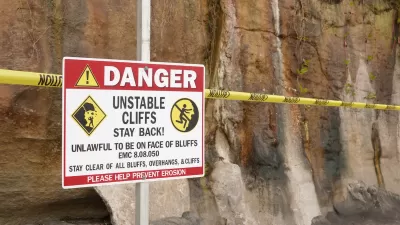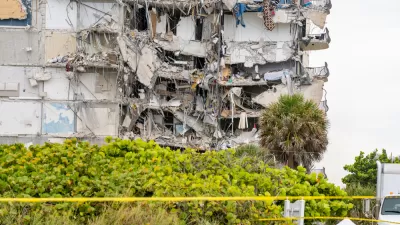The weight of large buildings may not be a major threat to coastal cities, despite recent claims.

John A. Egan and Ronald O. Hamburger, in a piece for the San Francisco Chronicle, challenge a recent article in the same publication that claimed the San Francisco Bay area is literally sinking under the weight of high-rise development. The article's "alarming language suggests that this is a sudden phenomenon, and that San Francisco, in particular, is at risk of sinking underwater as bay fill is compressed by the weight of the skyscrapers that rest upon it." The authors argue this is an exaggeration of dynamics that are neither new "nor among the serious threats to coastal areas from global warming."
Since at least the 1930s, civil engineers have been aware of the settlement performance of buildings and the potential for subsidence in downtown San Francisco, where parts of the shore were filled in more than a century ago. But most buildings are anchored farther down than the infill layer, and the effects of "differential settlement" don't stretch far beyond the building itself, according to the authors. Millennium Tower, one of the buildings highlighted in the prior article for its effects on the soil, "is supported by a foundation with nearly 1,000 concrete piles that extend beyond the fill into dense sands about 80 feet below the ground" and is undergoing an additional upgrade with new pilings that will anchor it even deeper. "Despite the dramatic numbers scenario outlined in the Chronicle piece, we advise caution about settlement predictions that are based on the aggregate weight of urban development."
FULL STORY: Don't blame the high-rises for Bay Area's subsidence

Maui's Vacation Rental Debate Turns Ugly
Verbal attacks, misinformation campaigns and fistfights plague a high-stakes debate to convert thousands of vacation rentals into long-term housing.

Planetizen Federal Action Tracker
A weekly monitor of how Trump’s orders and actions are impacting planners and planning in America.

San Francisco Suspends Traffic Calming Amidst Record Deaths
Citing “a challenging fiscal landscape,” the city will cease the program on the heels of 42 traffic deaths, including 24 pedestrians.

Defunct Pittsburgh Power Plant to Become Residential Tower
A decommissioned steam heat plant will be redeveloped into almost 100 affordable housing units.

Trump Prompts Restructuring of Transportation Research Board in “Unprecedented Overreach”
The TRB has eliminated more than half of its committees including those focused on climate, equity, and cities.

Amtrak Rolls Out New Orleans to Alabama “Mardi Gras” Train
The new service will operate morning and evening departures between Mobile and New Orleans.
Urban Design for Planners 1: Software Tools
This six-course series explores essential urban design concepts using open source software and equips planners with the tools they need to participate fully in the urban design process.
Planning for Universal Design
Learn the tools for implementing Universal Design in planning regulations.
Heyer Gruel & Associates PA
JM Goldson LLC
Custer County Colorado
City of Camden Redevelopment Agency
City of Astoria
Transportation Research & Education Center (TREC) at Portland State University
Jefferson Parish Government
Camden Redevelopment Agency
City of Claremont





























